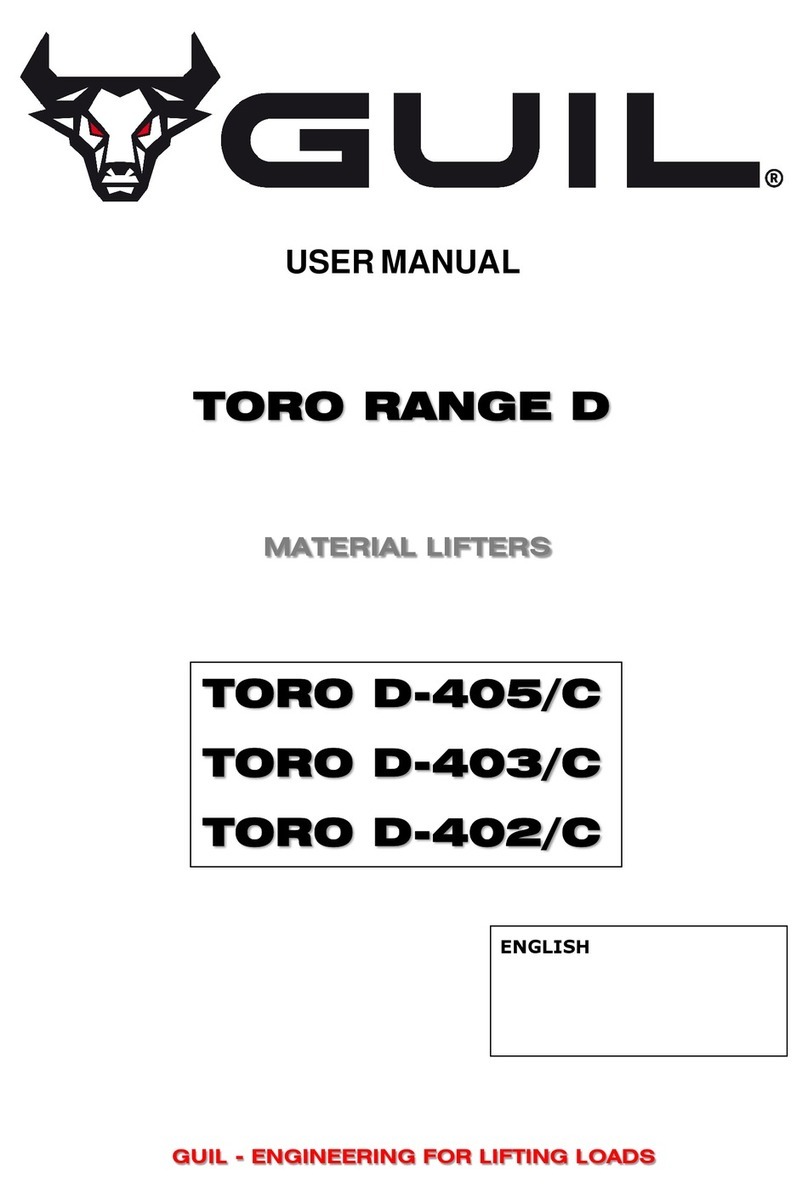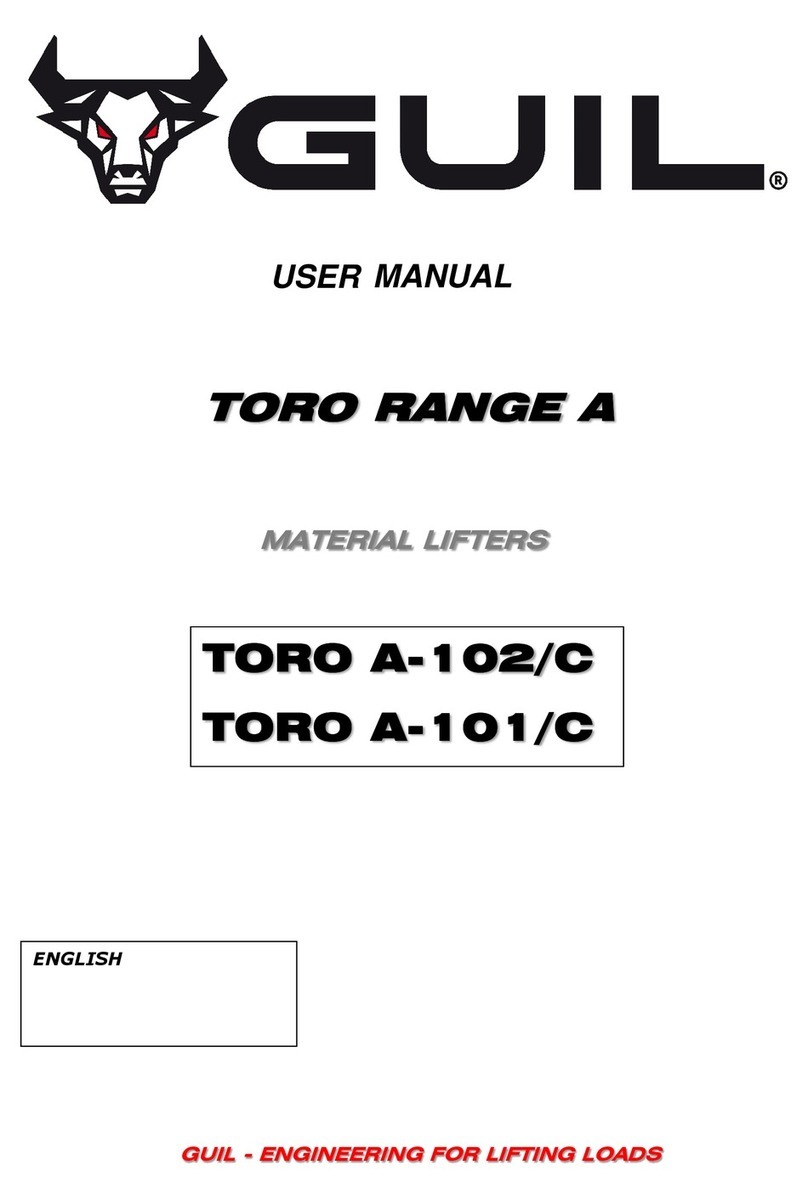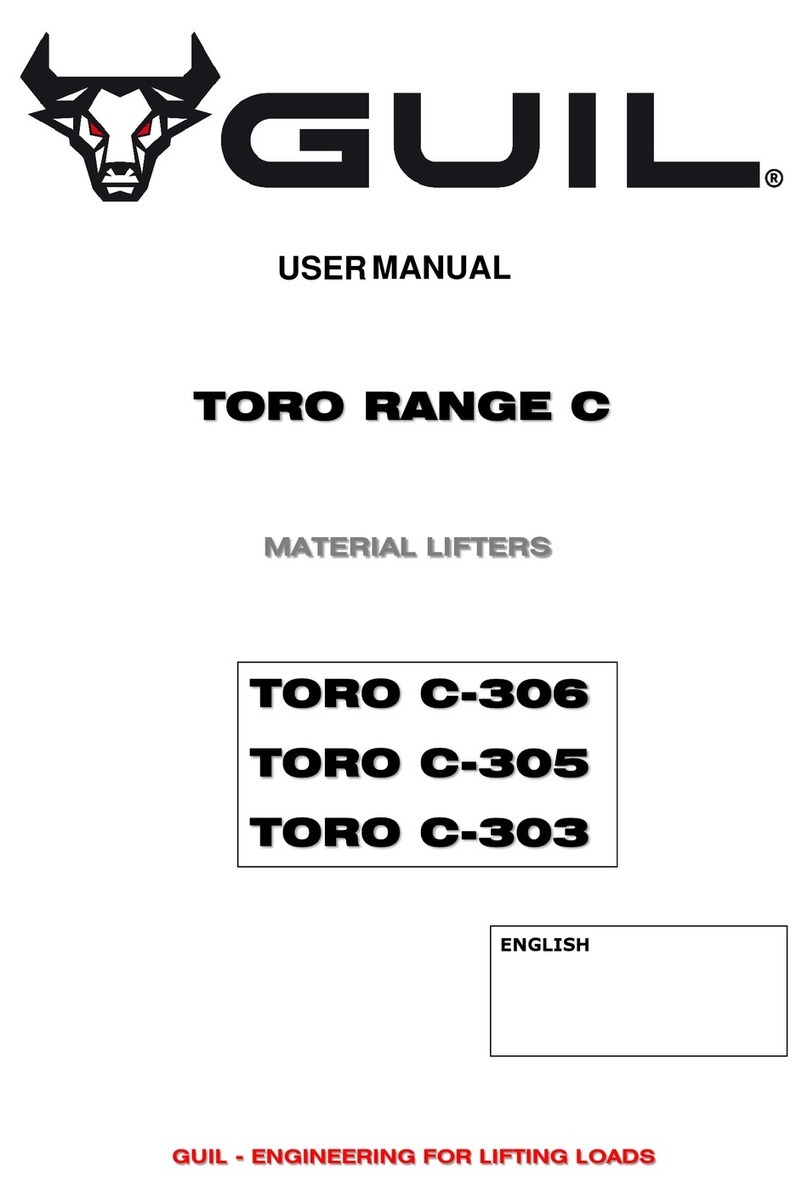
www.guil.es - GUIL -
-
CONTENTS
Introduction ……………………………………………………………………………
Owner and User’s Obligations ………………………………………………
Operator Safety Instructions …………………………………………………
Pre-operation Inspection …………
………………………………………………………………………………
Operating Instructions …………………………………………………………
Transport ………………………………………………………………………………
Maintenance ……………………………………………………………………………
Guarantee ………………………………………………………………………………
Components …………………………………………………………………………………………………………………… 13
Load Table
…………………………………………………………………………………………………………………… 1
Certificate ……………………………
…………………………………………………………………………………
Maintenance sheet
for the tower ……………………………………………………………………………
INTRODUCTION
Thank you for having chosen a
GUIL
®
lifting tower. Your machine left our premises in
absolutely perfect condition. To maintain this condition and to ensure a safe use, it is
absolutely necessary for the
user to read, understand and obey the safety and operating
instructions in this manual as it contains information that will give you a thorough
knowledge of the workings of your TORO
tower and guarantee maximum safety whilst
operating it.
Important: Dam
ages caused by the disregard of this user manual are not subject to
warranty; neither the dealer nor the manufacturer accepts liability for any resulting
damages to property or personal injury.
OWNER AND USER’S OB IGATIONS
Everyone involved with the ins
tallation, operation and maintenance of this lifting tower
must:
- be sufficiently qualified, trained or experienced
- follow the instructions of this manual
- keep this manual for the entire service life of the product
- pass this manual on to every future owner or user of the tower.
regarded as a permanent part of your lift and should remain with the lifting tower at all
times.
-
If the manual is misplaced please contact your dealer or manufacturer
Before putting the tower into service please make sure that there is no damage caused
during transportation. Should there be any, consult your dealer or the manufacturer
(
GUIL
®
) and do not use the stand.
DANGER TO IFE!
Failure to comply with the safety or operating instructions in the manual may result in damage to
property, serious personal injury or even death!
Pag.
8
8
8 + 9
………………………………………………………………………………
… 9 + 10
10, 11 + 12
12
13
Components …………………………………………………………………………………………………………………… 13
…………………………………………………………………………………………………………………… 1
4
…………………………………………………………………………………
……… 15
for the tower ……………………………………………………………………………
……… 16
lifting tower. Your machine left our premises in
absolutely perfect condition. To maintain this condition and to ensure a safe use, it is
user to read, understand and obey the safety and operating
instructions in this manual as it contains information that will give you a thorough
tower and guarantee maximum safety whilst
ages caused by the disregard of this user manual are not subject to
warranty; neither the dealer nor the manufacturer accepts liability for any resulting
OWNER AND USER’S OB IGATIONS
tallation, operation and maintenance of this lifting tower
This manual should be
regarded as a permanent part of your lift and should remain with the lifting tower at all
If the manual is misplaced please contact your dealer or manufacturer
(
GUIL
®
).
Before putting the tower into service please make sure that there is no damage caused
during transportation. Should there be any, consult your dealer or the manufacturer
OPERATOR SAFETY INSTRUCTIONS
SET-UP AND WORKING AREA SAFETY
Prior to set-
up, be aware of and avoid the following hazardous situations
•Drop-offs
or holes which impede the tower being
jacks.
Pot holes, obstacles on the floor or
•Slopes that exceed the ad
justment capabilities of the tower.
•Unstable or slippery surfaces.
•Hazardous locations.
Aerial obstacles or overhead electric cables
•
Inadequate surface support to withstand all load forces imposed by the tower.
•
Weather conditions and strong winds
•The pre
sence of unauthorised personnel.
T
Do not stand under or allow personnel under the
load is raised, making sure a safety area is blocked around the tower,
which should have a diameter of 1.5 times the height of the tower.
T Do
not lower the load unless the area below is clear of personnel and
obstructions.
T Never use the TORO
lifting tower in strong or gusty wind.
T Do no
t use this lifting tower outdoors if it is thundering and lightning or
adverse weather…Never use the
weather conditions. NOTE: Increasing the
machine stability in windy conditions.
T Avoid transporting the
debris
when in the folded position.
T N
ever use the tower on moving surfaces or vehicles
T The TORO
lift must always be set up on firm and even surfaces.
T This TORO
you if it
gets close to or comes into contact with electricity.
T If the TORO
tower comes into contact with electric cable, keep well away.
The tower should not be touched or used until the electricity has been
off.
T
Maintain safe distances away from electrical power lines and apparatus,
allowing for mast movement and electrical line sway or sag, in accordance
with applicable local governmental regulations
T
Do not use the lifting tower as a g
Failure to comply with the safety or operating instructions in the manual may result in damage to
www.guil.es - GUIL -
-
OPERATOR SAFETY INSTRUCTIONS
up, be aware of and avoid the following hazardous situations
:
or holes which impede the tower being
levelled using only the leveling
Pot holes, obstacles on the floor or
debris.
justment capabilities of the tower.
Aerial obstacles or overhead electric cables
.
Inadequate surface support to withstand all load forces imposed by the tower.
Weather conditions and strong winds
.
sence of unauthorised personnel.
Do not stand under or allow personnel under the
TORO tower when the
load is raised, making sure a safety area is blocked around the tower,
which should have a diameter of 1.5 times the height of the tower.
not lower the load unless the area below is clear of personnel and
lifting tower in strong or gusty wind.
t use this lifting tower outdoors if it is thundering and lightning or
adverse weather…Never use the
TORO tower in the event of extreme
weather conditions. NOTE: Increasing the
load surface area will decrease
machine stability in windy conditions.
lift over uneven surfaces or ground with
when in the folded position.
ever use the tower on moving surfaces or vehicles
.
lift must always be set up on firm and even surfaces.
electrically insulated and does not protect
gets close to or comes into contact with electricity.
tower comes into contact with electric cable, keep well away.
The tower should not be touched or used until the electricity has been
switch
Maintain safe distances away from electrical power lines and apparatus,
allowing for mast movement and electrical line sway or sag, in accordance
with applicable local governmental regulations
.
Do not use the lifting tower as a g
round for welding. 8






























